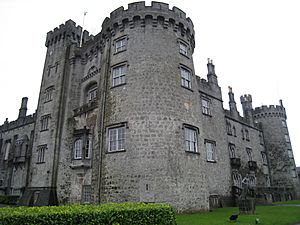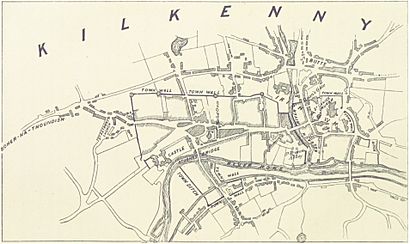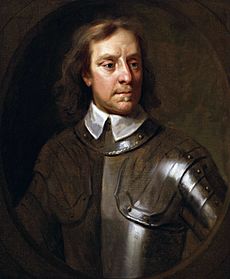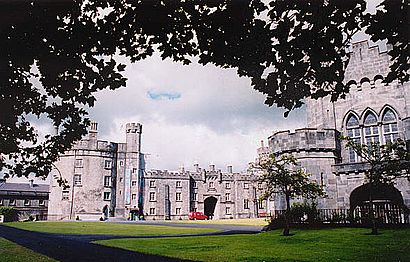Siege of Kilkenny facts for kids
Quick facts for kids Siege of Kilkenny |
|||||||
|---|---|---|---|---|---|---|---|
| Part of the Cromwellian Conquest of Ireland | |||||||
 Kilkenny Castle |
|||||||
|
|||||||
| Belligerents | |||||||
| Commanders and leaders | |||||||
| Oliver Cromwell | Sir Walter Butler | ||||||
| Strength | |||||||
| 4,000 Soldiers | 300 Soldiersand Civilian Militia |
||||||
| Casualties and losses | |||||||
| up to 200 killed or wounded | up to 100 killed, wounded or captured | ||||||
The Siege of Kilkenny was a big battle in March 1650. It happened when Oliver Cromwell and his New Model Army attacked Kilkenny. Kilkenny was the main city for the Irish Confederates. This siege was part of Cromwell's plan to take control of Ireland.
Contents
Why the Siege Happened
In August 1649, a year after the Second English Civil War, Oliver Cromwell came to Ireland. He brought the English Parliament's army, called the New Model Army. Their goal was to take back control from the combined forces of the English Royalists and the Irish Confederates.
Cromwell's army moved quickly. They captured cities like Drogheda, Belfast, and Carrickfergus in the north. They also took port cities in the southeast, like Wexford and New Ross. This all happened before winter arrived.
In January 1650, Cromwell started his campaign again. His main goal was to capture Kilkenny, the Confederate capital. He also wanted to take Clonmel, another strong fort. Cromwell split his army into groups. These groups attacked smaller Royalist forts in Munster and Leinster. Many forts were left empty by the Royalists. Others gave up without a fight. By early March, Cromwell's forces were closing in on Kilkenny.
Kilkenny City Layout
Kilkenny was a strong, walled city. It had three separate walled areas.
- High Town was next to Kilkenny Castle. The River Nore was on its east side.
- Irish Town was north of High Town. It was also next to the River Nore.
- St. John's was on the east side of the River Nore. It connected to High Town by St. John's Bridge.
Some streets from High Town, like High Street and St. Kieran Street, are still there today.
Before the Attack
Cromwell first tried to capture Kilkenny with a secret plan. He bribed an Irish officer named Captain Tickle. Tickle was supposed to open a city gate for Cromwell's soldiers. But when Cromwell's forces arrived, the gate was closed and guarded. Tickle's plan had been found out, and he was hanged.
Soon after, the leader of the Royalists, the Duke of Ormond, left Kilkenny. He went to a safer castle in Limerick. Sir Walter Butler was left in charge of Kilkenny's defenses.
Butler faced many problems. He had only about 300 soldiers, not the usual 1,000. Many soldiers had been lost to a sickness over the winter. Because of this, Butler had to use all his soldiers to defend High Town and Kilkenny Castle. He left Irish Town and St. John's to be defended by local people, called a civilian militia.
The Siege Begins
On March 22, Cromwell's army reached Kilkenny. Cromwell immediately offered the city a chance to surrender. But Butler refused the next day. So, Cromwell's forces surrounded the city and began the attack.
Cromwell first sent cavalry to attack the gate of Irish Town. But the civilian militia fought hard and pushed Cromwell's soldiers back. At the same time, Cromwell's men took control of the area around St. Patrick's Church. This gave them a good spot for their cannons.
On March 24, Cromwell set up his cannons but did not attack. On the morning of March 25, he started firing at the southern wall of High Town. By noon, the wall was broken. Cromwell ordered his men to attack. They stormed the wall and got inside High Town. But they were met with strong musket fire from inside defenses. Cromwell's forces were forced to retreat.
Later that day, Cromwell sent another force to attack Dean's Gate in Irish Town. This time, they used both foot soldiers and cavalry. This attack was successful. The civilian militia was quickly defeated, and Cromwell's soldiers took control of Irish Town. Cromwell then offered surrender terms again. He gave Butler time to think about it.
While waiting, Cromwell sent soldiers across the River Nore to attack St. John's. They easily fought their way in. The defenders ran across St. John's Bridge into High Town. Cromwell's soldiers chased them but were stopped at the gatehouse to High Town.
At this point, Butler and the Royalists were in a very difficult spot.
- Cromwell's cannons at St. Patrick's Church could still hit High Town's southern wall.
- Cromwell's forces held St. John's. They were ready to attack the bridge gatehouse and High Town wall by the river.
- Cromwell's forces also held the higher ground of Irish Town. They were setting up more cannons there to fire at High Town's northeastern walls.
By the morning of March 27, Cromwell's cannons from Irish Town had made a second hole in the High Town wall. This hole was near the Franciscan Abbey. Butler now had to defend three possible entry points into High Town. To make things worse, General Henry Ireton arrived with 1,500 more soldiers for Cromwell.
Butler saw that he could not defend Kilkenny's High Town and castle against such a large attack. So, he accepted Cromwell's terms of surrender. He was actually following orders from Lord Castlehaven. These orders said that if no help came, he should surrender to avoid a terrible fight and get the best terms possible.
What Happened Next
On March 28, 1650, Kilkenny city and its castle were given to Cromwell. All weapons, ammunition, and public supplies were also handed over. The people of the city could leave safely. If they stayed, they would be protected from the soldiers. The Royalist and Irish Confederate officers and soldiers were allowed to march out of the city. They could take their flags, bags, horses, and weapons with them.
As the soldiers marched out, Cromwell praised them for their bravery. He told them that his army had lost more soldiers in Kilkenny than they had at Drogheda. The exact number of soldiers lost on each side is not known. But it is thought to be low. Most of the fighting happened at the broken southern wall of High Town.
After Kilkenny, Cromwell went on to take Clonmel on May 18. His army suffered many losses there. Then he returned to England (see Siege of Clonmel). The Parliamentarian army, led by Ireton, continued fighting for about two more years. They finally ended the organized Irish and Royalist resistance at Galway in May 1652. However, some Irish forces continued to fight in smaller groups for a while after that.




